You are here
CBO Warns Fiscal Path is Unsustainable and Threatens Economic Growth
Highlights
While the current year deficit projection has improved, federal deficits will begin rising in just three years and major long-term fiscal challenges remain unaddressed, according to a new Congressional Budget Office (CBO) report. Even as the economic recovery strengthens, this structural fiscal imbalance threatens to restrain future economic growth.
CBO projects that:
- Economic activity next year will expand at a solid pace, with the unemployment rate declining to 5.1 percent and the Federal Reserve raising interest rates as the economic conditions improve. However, CBO warns of significant harm to the economy over the long term if structural fiscal imbalances are not addressed.
- The current year deficit is projected to be $426 billion. Debt levels over the next 10 years will remain at historically high levels, reaching 77 percent of gross domestic product (GDP) in 2025 — double the 50-year average. Debt levels thereafter will increase sharply as a share of GDP.
- Net interest costs will increase significantly over the next ten years, totaling $5.2 trillion and becoming the third largest category in the federal budget by 2024.
CBO warns that our long-term fiscal challenges put our economy at risk:
"Such high and rising debt would have serious negative consequences both for the economy and for the federal budget. When interest rates rise to more typical levels — as CBO expects will be the case in the next few years — federal spending on interest payments will increase considerably. Moreover, federal borrowing boosts the overall demand for funds, and that in turn generally raises the cost of borrowing and reduces the amount of lending in the economy at large. The eventual result would be a smaller stock of capital and lower output and income than would otherwise be the case, all else being equal. In addition, the large amount of debt could restrict policymakers’ ability to use tax and spending policies to respond to unexpected challenges, such as economic downturns or financial crises. Finally, continued growth in the debt might lead investors to doubt the government’s willingness or ability to pay its obligations, which would require the government to pay much higher interest rates on its borrowing.”
Economy has improved significantly
The strengthening of the economy has been a significant factor in the improvement of our short-term budgetary situation since 2009. The unemployment rate is expected to decline to 5.1 percent in 2016 and to 5.0 percent in 2017 before stabilizing at its long-run value of 5.2 percent, which approximately 45 percent below the level that it was in 2009.
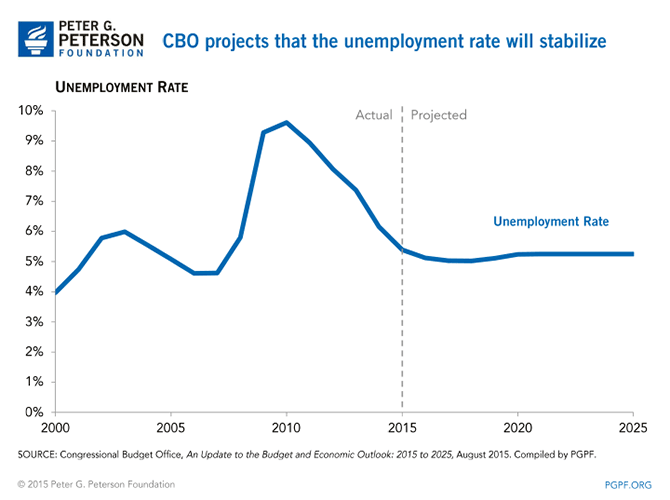
With the improved economy, the Federal Reserve is expected to begin tightening monetary policy and raising interest rates1. CBO forecasts that the interest rate on the 3-month Treasury bills will rise from 0.1 percent in 2015 to 0.7 percent in 2016 and to 3.4 percent in 2025. Interest rates on 10-year Treasury notes are projected to increase from 2.3 in 2015 to 3.0 in 2016 to 4.3 in 2025.

Although current federal deficits have declined, they will begin rising again soon
Deficits have declined steadily since the Great Recession in 2009. At its peak in 2009, the deficit reached $1.4 trillion. CBO now projects a deficit of $426 billion for 2015. This is due in part to the return of more normal levels of economic activity, which boosts revenues and reduces certain temporary spending, such as unemployment benefits and stimulus.
However, CBO also projects that deficits will begin rising in just three years. Over the next 10 years, the deficit will more than double from $426 billion in 2015 to over $1 trillion in 2025, resulting in a cumulative 10-year deficit of $7.0 trillion, according to CBO.
The projected deficits are the result of the growing structural gap between the federal government’s spending and the amount of revenue it collects. Over the next 10 years, CBO estimates that revenues will remain roughly stable at 18.3 percent of GDP. However, spending is expected to rise over the same period, increasing from 20.6 percent of GDP in 2015 to 22.0 percent in 2025. Over ten years, CBO projects total federal spending of $48.6 trillion, while total federal revenues will be only $41.6 trillion. Over the long term, this structural gap widens significantly.

Federal debt remains historically high
CBO projects that federal debt will reach 77 percent of GDP in 2025. Historically, that is a very high level of debt. Since 1790, there have been only 7 years in which the debt was above 75 percent of GDP, and those were during and just after World War II. Beginning in 1947, debt began to fall sharply as a share of GDP, as the economy boomed and some debt was paid down. Today, the budget outlook is much more worrisome because the projections show a dramatic increase in debt and only modest economic growth.
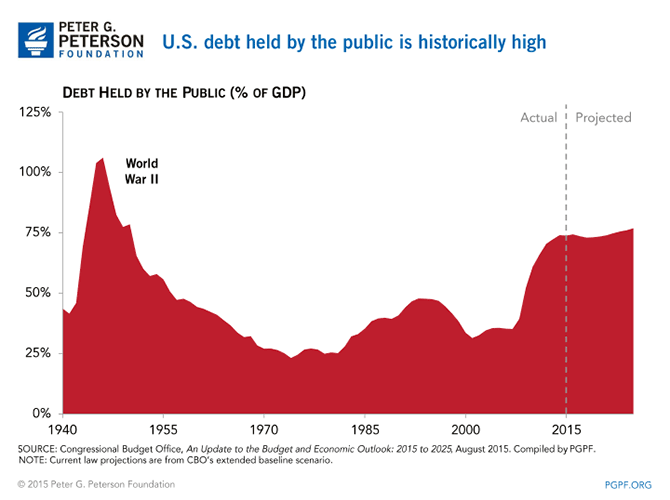
Interest costs are projected to climb significantly from growing debts and rising interest rates
As debt continues to accumulate and interest rates increase, net interest costs are projected to more than triple over the decade, soaring from $218 billion in 2015 to $755 billion in 2025. Over 10 years, interest costs total $5.2 trillion. In 2024, net interest costs are projected to become the third largest category in the budget, after Social Security and Medicare.
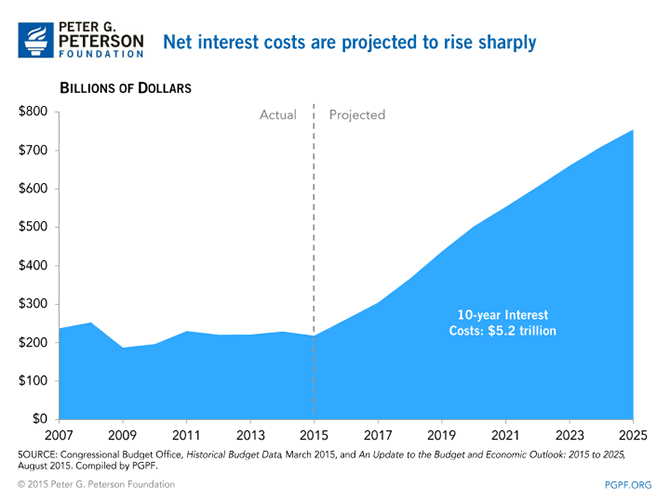
Mandatory spending is projected to climb significantly
Mandatory spending (excluding net interest) is expected to increase from $2.3 trillion in 2015 to $3.9 trillion in 2025. This rise is attributable primarily to increased spending for major health care programs and Social Security.
- Major health programs: CBO projects that net spending for the major health programs will climb from $937 billion in 2015 to $1.7 trillion in 2025. That increase reflects growth in three major programs: Medicare, Medicaid, and the exchange subsidies.
- Medicare: As a growing number of baby boomers turn 65 and costs per beneficiary increase, net spending for Medicare will rise from $541 billion in 2015 to over $1 trillion in 2025.
- Medicaid: Fueled by state expansion of health insurance under the Affordable Care Act, Medicaid spending is expected to rise from $350 billion in 2015 to $571 billion in 2025.
- Social Security: Spending on Social Security, currently the largest single federal program, will grow from $882 billion in 2015 to $1.5 trillion in 2025, driven primarily by the retirement of the large baby-boom generation.
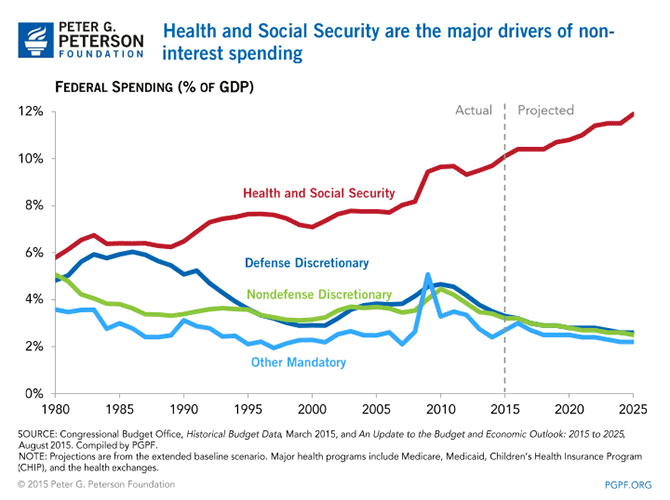
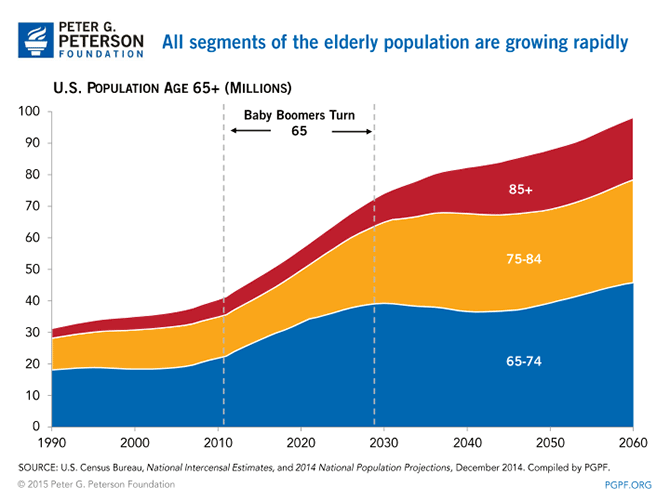
While mandatory spending and interest costs are projected to climb, federal spending devoted to discretionary programs will fall to historic lows ― from 6.5 percent of GDP in 2015 to 5.1 percent of GDP in 2025. At this level, discretionary spending would be nearly 30 percent below its average over the last 20 years, and lower than it has been in any year recorded in its history.
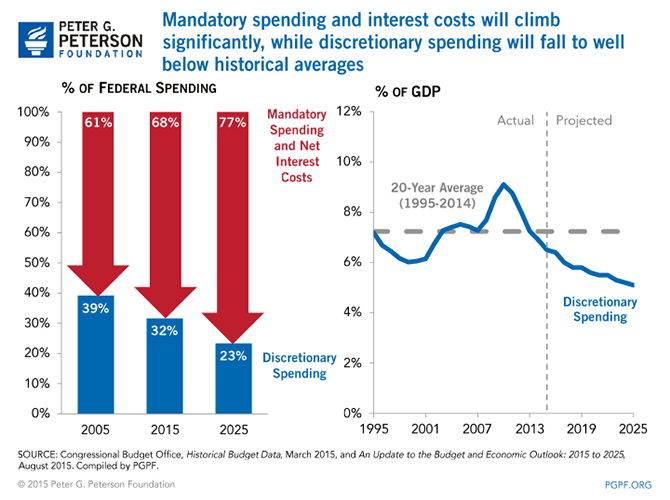
The time for policymakers to act is now
CBO’s report provides a stark warning that deficits will grow again soon, and that our country faces dangerous levels of debt in the future. Even as the recovery strengthens, CBO warns that the unsustainable trajectory of our long-term debt threatens to restrain future economic growth.
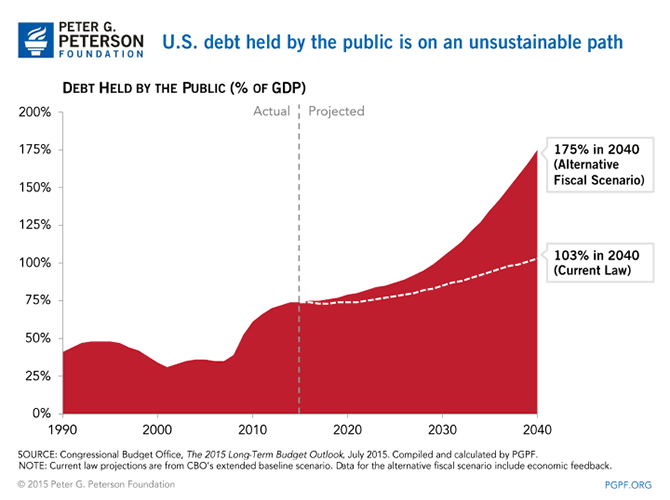
The long-term fiscal challenges facing the United States are serious. In its most recent long-term budget report, CBO estimates that within 25 years debt held by the public could climb to over 100 percent of GDP under current law and to a staggering 175 percent of GDP under less optimistic assumptions. Moreover, both the IMF and GAO also released reports this year warning about the dangers and unsustainability of U.S fiscal policy.
In recent years, many have said that the fragile nature of the recovery meant that it was not the right time to take fiscal action. Now, as the economic recovery continues to take hold, we have the opportunity to put in place sensible reforms that will put our long-term fiscal trajectory on a sustainable path.
1The Federal Reserve controls the federal funds rates, which influences many other interest rates including those on Treasury securities. (Back to citation)
